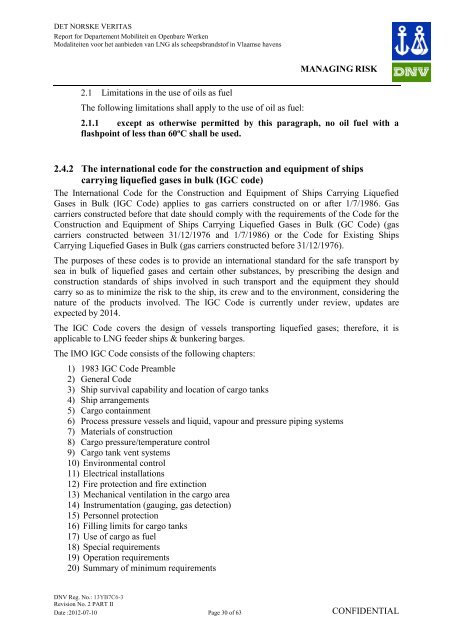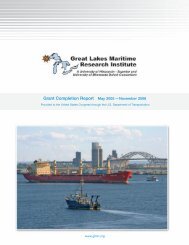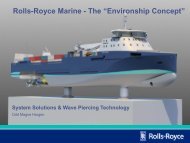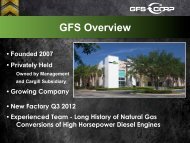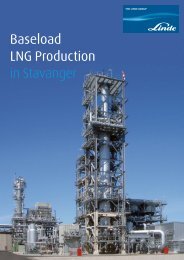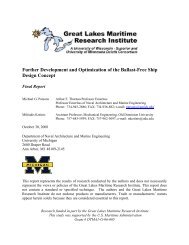Modalities for the provisioning of LNG as shipping fuel in Flemish Ports
Modalities for the provisioning of LNG as shipping fuel in Flemish Ports
Modalities for the provisioning of LNG as shipping fuel in Flemish Ports
You also want an ePaper? Increase the reach of your titles
YUMPU automatically turns print PDFs into web optimized ePapers that Google loves.
DET NORSKE VERITAS<br />
Report <strong>for</strong> Departement Mobiliteit en Openbare Werken<br />
Modaliteiten voor het aanbieden van <strong>LNG</strong> als scheepsbrandst<strong>of</strong> <strong>in</strong> Vlaamse havens<br />
MANAGING RISK<br />
2.1 Limitations <strong>in</strong> <strong>the</strong> use <strong>of</strong> oils <strong>as</strong> <strong>fuel</strong><br />
The follow<strong>in</strong>g limitations shall apply to <strong>the</strong> use <strong>of</strong> oil <strong>as</strong> <strong>fuel</strong>:<br />
2.1.1 except <strong>as</strong> o<strong>the</strong>rwise permitted by this paragraph, no oil <strong>fuel</strong> with a<br />
fl<strong>as</strong>hpo<strong>in</strong>t <strong>of</strong> less than 60ºC shall be used.<br />
2.4.2 The <strong>in</strong>ternational code <strong>for</strong> <strong>the</strong> construction and equipment <strong>of</strong> ships<br />
carry<strong>in</strong>g liquefied g<strong>as</strong>es <strong>in</strong> bulk (IGC code)<br />
The International Code <strong>for</strong> <strong>the</strong> Construction and Equipment <strong>of</strong> Ships Carry<strong>in</strong>g Liquefied<br />
G<strong>as</strong>es <strong>in</strong> Bulk (IGC Code) applies to g<strong>as</strong> carriers constructed on or after 1/7/1986. G<strong>as</strong><br />
carriers constructed be<strong>for</strong>e that date should comply with <strong>the</strong> requirements <strong>of</strong> <strong>the</strong> Code <strong>for</strong> <strong>the</strong><br />
Construction and Equipment <strong>of</strong> Ships Carry<strong>in</strong>g Liquefied G<strong>as</strong>es <strong>in</strong> Bulk (GC Code) (g<strong>as</strong><br />
carriers constructed between 31/12/1976 and 1/7/1986) or <strong>the</strong> Code <strong>for</strong> Exist<strong>in</strong>g Ships<br />
Carry<strong>in</strong>g Liquefied G<strong>as</strong>es <strong>in</strong> Bulk (g<strong>as</strong> carriers constructed be<strong>for</strong>e 31/12/1976).<br />
The purposes <strong>of</strong> <strong>the</strong>se codes is to provide an <strong>in</strong>ternational standard <strong>for</strong> <strong>the</strong> safe transport by<br />
sea <strong>in</strong> bulk <strong>of</strong> liquefied g<strong>as</strong>es and certa<strong>in</strong> o<strong>the</strong>r substances, by prescrib<strong>in</strong>g <strong>the</strong> design and<br />
construction standards <strong>of</strong> ships <strong>in</strong>volved <strong>in</strong> such transport and <strong>the</strong> equipment <strong>the</strong>y should<br />
carry so <strong>as</strong> to m<strong>in</strong>imize <strong>the</strong> risk to <strong>the</strong> ship, its crew and to <strong>the</strong> environment, consider<strong>in</strong>g <strong>the</strong><br />
nature <strong>of</strong> <strong>the</strong> products <strong>in</strong>volved. The IGC Code is currently under review, updates are<br />
expected by 2014.<br />
The IGC Code covers <strong>the</strong> design <strong>of</strong> vessels transport<strong>in</strong>g liquefied g<strong>as</strong>es; <strong>the</strong>re<strong>for</strong>e, it is<br />
applicable to <strong>LNG</strong> feeder ships & bunker<strong>in</strong>g barges.<br />
The IMO IGC Code consists <strong>of</strong> <strong>the</strong> follow<strong>in</strong>g chapters:<br />
1) 1983 IGC Code Preamble<br />
2) General Code<br />
3) Ship survival capability and location <strong>of</strong> cargo tanks<br />
4) Ship arrangements<br />
5) Cargo conta<strong>in</strong>ment<br />
6) Process pressure vessels and liquid, vapour and pressure pip<strong>in</strong>g systems<br />
7) Materials <strong>of</strong> construction<br />
8) Cargo pressure/temperature control<br />
9) Cargo tank vent systems<br />
10) Environmental control<br />
11) Electrical <strong>in</strong>stallations<br />
12) Fire protection and fire ext<strong>in</strong>ction<br />
13) Mechanical ventilation <strong>in</strong> <strong>the</strong> cargo area<br />
14) Instrumentation (gaug<strong>in</strong>g, g<strong>as</strong> detection)<br />
15) Personnel protection<br />
16) Fill<strong>in</strong>g limits <strong>for</strong> cargo tanks<br />
17) Use <strong>of</strong> cargo <strong>as</strong> <strong>fuel</strong><br />
18) Special requirements<br />
19) Operation requirements<br />
20) Summary <strong>of</strong> m<strong>in</strong>imum requirements<br />
DNV Reg. No.: 13YB7C6-3<br />
Revision No. 2 PART II<br />
Date :2012-07-10 Page 30 <strong>of</strong> 63 CONFIDENTIAL


